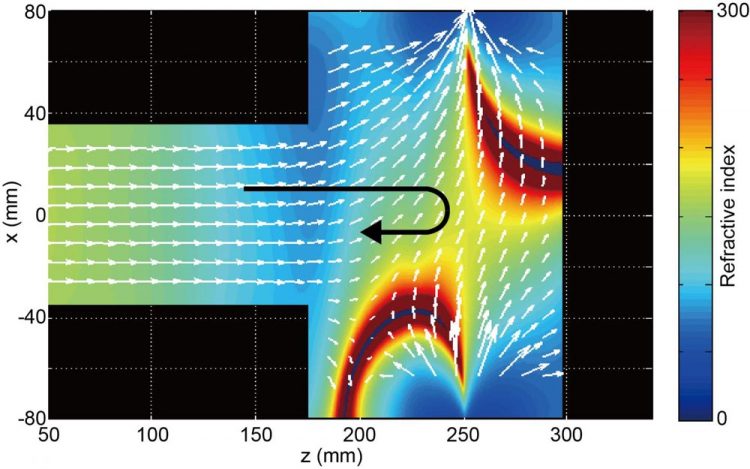New plasma source favorable for hydrogen negative ion beam is developed

Two-dimensional profiles of the magnetic field vector (white arrows) and the axial refractive index (contour plot). The bold black arrow indicates the reflection of the wave by the rapidly bent magnetic field. Credit: Kazunori Takahashi
Led by Associate Prof K. Takahashi and Prof A. Ando, the team demonstrated adjoining generations of high and low electron temperature plasmas, based on the presently discovered plasma wave physics.
Development of neutral beam injection (NBI) heating system utilizing a hydrogen/deuterium (H/D) negative ion source, is significant for a fusion plasma reactor, which is one of the potential solutions to future energy-resource problems.
A very high temperature plasma state above 1.2 hundred billion degrees C (>10 keV) has to be sustained to maintain the fusion reaction; the NBI system plays an important role in heating the plasma. Once the negative ions are produced in a low-temperature plasma source, they are extracted electrostatically as an energetic beam. The negative ions are then neutralized via a gas neutralizer system and injected into the magnetically-confined plasma core.
Seeds of the negative ions are the H/D positive ions or atoms, which can be produced by collisions with high temperature electrons (~ 10 eV) and H/D molecules. On the other hand, it is well known that the energetic electrons destroy the negative ions.
Therefore, it would be favorable that the high electron temperature region for the seeds production exists close to the low temperature one for maintaining the negative ions. This inconsistent situation is realized in the present experiment by the newly discovered wave behavior.
The researchers found that the radiofrequency wave for the plasma production, called a helicon wave, is reflected by a local change of the refractive index (contour plot in Fig), which is introduced by the rapidly bent magnetic field structure (white arrows in Fig). Although there is no axial physical boundary downstream of the source, the wave recognizes the bent magnetic field structure as the boundary and is reflected there (black arrow in Fig).
As a result of the wave reflection, a standing wave yielding the high temperature electrons is generated upstream of the vertical magnetic fields. Since the wave energy cannot go inside the vertical magnetic fields, which also play a role in separating the high and low energy electrons, the low temperature electrons can be obtained downstream of the vertical magnetic fields.
The experiment has just started and currently only shows the low temperature plasma production; the detailed investigations on the negative ion production and the beam extraction will be progressed hereafter. The above-mentioned plasma source based on the wave physics will provide various applications for plasma processing devices, in addition to the application to the negative ion source.
Media Contact
All latest news from the category: Physics and Astronomy
This area deals with the fundamental laws and building blocks of nature and how they interact, the properties and the behavior of matter, and research into space and time and their structures.
innovations-report provides in-depth reports and articles on subjects such as astrophysics, laser technologies, nuclear, quantum, particle and solid-state physics, nanotechnologies, planetary research and findings (Mars, Venus) and developments related to the Hubble Telescope.
Newest articles

Superradiant atoms could push the boundaries of how precisely time can be measured
Superradiant atoms can help us measure time more precisely than ever. In a new study, researchers from the University of Copenhagen present a new method for measuring the time interval,…

Ion thermoelectric conversion devices for near room temperature
The electrode sheet of the thermoelectric device consists of ionic hydrogel, which is sandwiched between the electrodes to form, and the Prussian blue on the electrode undergoes a redox reaction…

Zap Energy achieves 37-million-degree temperatures in a compact device
New publication reports record electron temperatures for a small-scale, sheared-flow-stabilized Z-pinch fusion device. In the nine decades since humans first produced fusion reactions, only a few fusion technologies have demonstrated…





















